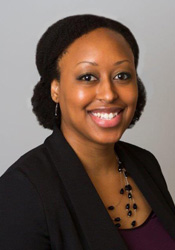DCTD Programs
DCTD Workforce

Message from DCTD Director, Dr. James H. Doroshow
As part of NIH, DCTD is committed to Diversity, Equity, Inclusion, and Accessibility (DEIA) and providing a safe work environment for staff in our nine major programs that work together. We are pleased to have Dr. Leah Hubbard serving as DCTD’s Chief Diversity Officer to help us ensure DEIA in DCTD and to assist with DEIA questions, comments, and concerns.
Please see below for more information about DCTD’s commitment to workforce inclusion, safe workplaces, DEIA in recruitment/hiring, and accountability. We also provide resources on NIH/NCI DEIA activities, training opportunities, and staff professional development.
DCTD Commitments to DEIA
- Inclusion
- A Safe Workplace
- DEIA in Recruitment and Hiring
- Accountability

Inclusion
DCTD is committed to being an inclusive workplace where all staff feel welcome, valued, supported, recognized, and respected. To ensure an inclusive DCTD work environment, we are implementing the following:
- Staff recognition throughout the division by highlighting staff accomplishments, areas of interest, and length of service in the DCTD newsletter and social media platforms.
- Evaluation of staff feedback regarding the DCTD workplace climate (e.g., Federal Employment Viewpoint Survey and NCI anonymous feedback tool, NCI Internal Link) and reasons for DCTD employee separation.

A Safe Workplace
DCTD is committed to a workplace free of racism, harassment, discrimination, and bullying. In alignment with NIH policies and values, DCTD abides by and provides all staff with the following resources:

DEIA in Recruitment and Hiring
DCTD is committed to promoting DEIA in recruitment and hiring, as demonstrated through the following activities:
- Outreach & Engagement: We have implemented new procedures for broadly advertising DCTD job openings and promoting targeted outreach/engagement with candidates from underrepresented groups.
- Hiring Best Practices: We are collaborating with the NCI Equity and Inclusion Program to develop a hiring best practices toolkit and training. The toolkit and training will provide NCI staff with the resources and training required to ensure DEIA in every aspect of the hiring process. Examples of current hiring best practices resources DCTD is utilizing include:

Accountability
DCTD is committed to ensuring DEIA in our workforce, hiring practices, and workplace culture through leadership accountability:
- Chief Diversity Officer (CDO): The DCTD CDO, Dr. Leah Hubbard, serves as the advisor to DCTD leadership to enhance DEIA in the division; supports programs to improve DEIA in the workplace culture, recruitment, and hiring; and serves as the DEIA point of contact for DCTD staff.
- Leadership Meetings: The DCTD CDO meets quarterly with DCTD Associate Directors and monthly with DCTD leadership to address concerns reported by DCTD staff and to evaluate implementation of DEIA recruitment, hiring, and retention strategies.
- Required Training: DCTD leadership complete all required NIH DEIA and anti-harassment training for supervisors and participate in additional training provided by NIH and the NCI Office of Workforce Planning and Development:
- NIH Anti-Harassment Training and Additional Course Offerings
- NCI Employee Training and Services (NCI internal link)
- NCI Racial and Ethnic Equity Plan (REEP) (NCI internal link): describes DEIA training and requirements for NCI supervisors.
DEIA Resources
- NIH/NCI Activities
- Training & Other Resources
- Professional Development
- Contact Us
NIH/NCI Activities
- DCTD DEIA Activities
Updates on DCTD DEIA activities are provided in the DCTD quarterly newsletter. - NCI Equity and Inclusion Program
The NCI Equity and Inclusion Program is an initiative to increase the diversity of the cancer research workforce; build a more inclusive and equitable NCI community; address cancer disparities; and advance health equity. - NCI Racial and Ethnic Equity Plan (REEP) (NCI internal link)
NCI’s action plan to ensure an equitable and fair workplace. - NIH-Wide Strategic Plan for DEIA
NIH's strategic plan for growing and sustaining DEIA through structural and cultural change; implementing organizational practices to center and prioritize DEIA in the biomedical and behavioral research workforce; and advancing DEIA through research. - NIH UNITE
UNITE is an NIH initiative to identify and address structural racism within the agency and throughout the biomedical and behavioral workforce.
Training & Other Resources
- NCI Equity Toolkit (NCI internal link)
The Equity Toolkit equips the NCI community with resources and a framework to engage in conversation about race, social inequities, and other thought-provoking topics. - NIH DEIA Courses
NIH staff courses covering DEIA, harassment, reasonable accommodation, EEO compliance, and more. - NCI DEIA Resources List (NCI internal link)
Resources related to NIH/NCI equity and inclusion; funding opportunities and research; training; blogs, articles, and events; inclusive language; and policies. - NCI Workforce Demographics (NCI internal link)
A profile of NCI’s workforce, including data broken down by race, ethnicity, gender, and employee type. - NIH Workforce Demographics
Describes the demographic composition of each NIH Institute and Center's workforce. - NIH Office of Equity, Diversity, and Inclusion
Provides programs and services to ensure equal employment opportunity (EEO), diversity, equity, and inclusion at NIH. - NIH Scientific Workforce Diversity Office
Leads NIH's effort to diversify the national scientific workforce and expand recruitment and retention.
Professional Development
- NCI Employee Training and Services (NCI internal link)
Career coaching services, mentorship programs, team building courses, leadership training, and more. - NIH Professional Development Courses
Courses designed to enhance existing skills, improve effectiveness, and prepare for career advancement at NIH. - NIH Leadership Training
Continuum of leadership development programs to build leadership skills. - NCI PRESTO (NCI internal link)
NCI Program and Review Extramural Staff Training Office resources and training. - DCTD Job Opportunities
List of DCTD job openings
Contact Us

Your feedback is essential to improving DEIA in DCTD. Please submit any questions, comments, or concerns to:
Leah Hubbard, PhD
Chief Diversity Officer
Division of Cancer Treatment and Diagnosis
National Cancer Institute
Email: leah.hubbard@nih.gov
Phone: (240) 276-5693
About the Director
 James H. Doroshow, M.D., FACP, has been the Director of the Division of Cancer Treatment and Diagnosis (DCTD), National Cancer Institute (NCI), National Institutes of Health (NIH), since 2004. He is responsible for integrating the activities of DCTD with NCI’s other divisions and offices, as well as extramural scientists and clinicians, patient advocates, and professional cancer organizations. More…
James H. Doroshow, M.D., FACP, has been the Director of the Division of Cancer Treatment and Diagnosis (DCTD), National Cancer Institute (NCI), National Institutes of Health (NIH), since 2004. He is responsible for integrating the activities of DCTD with NCI’s other divisions and offices, as well as extramural scientists and clinicians, patient advocates, and professional cancer organizations. More…





